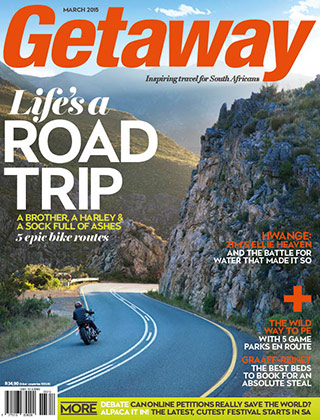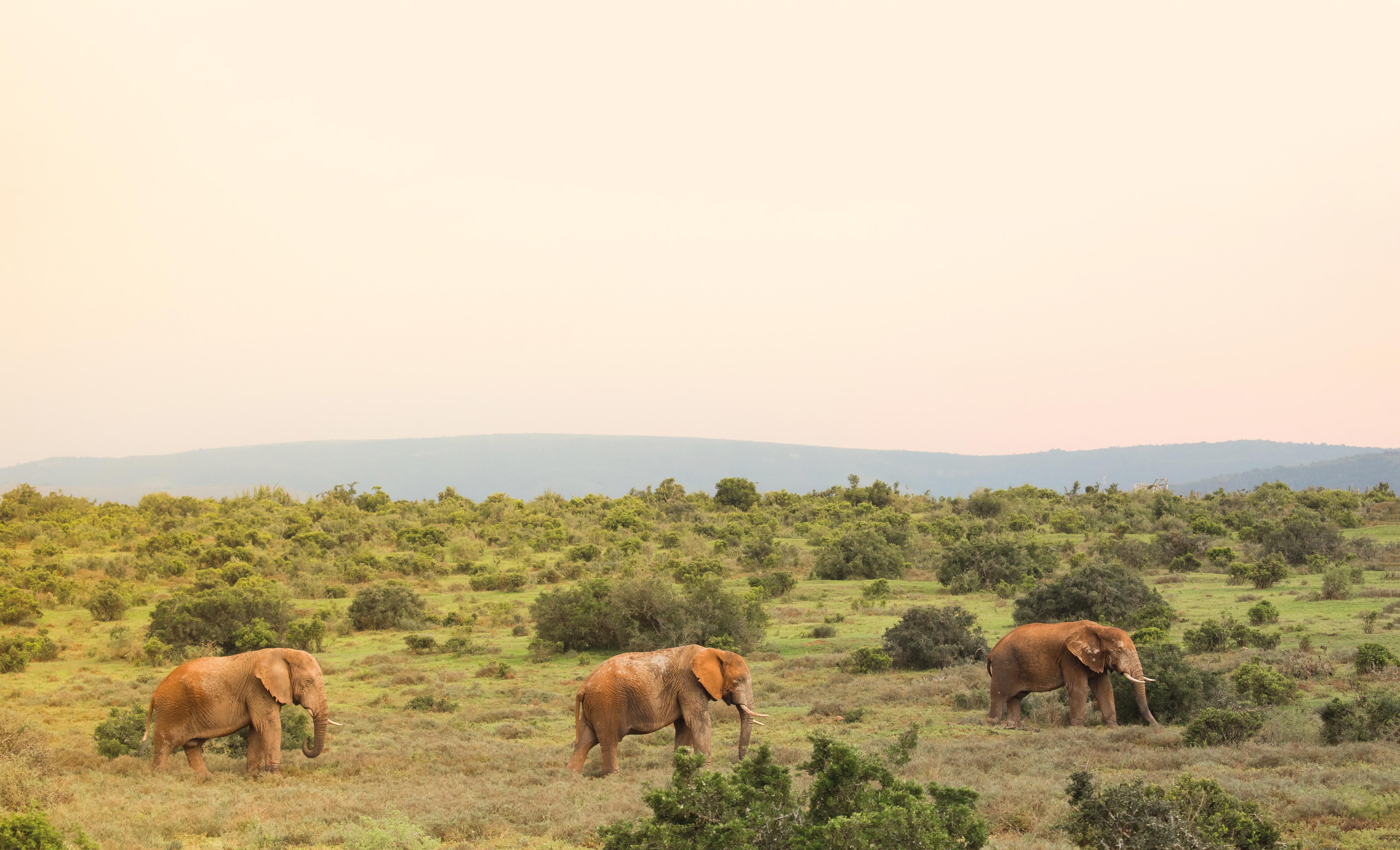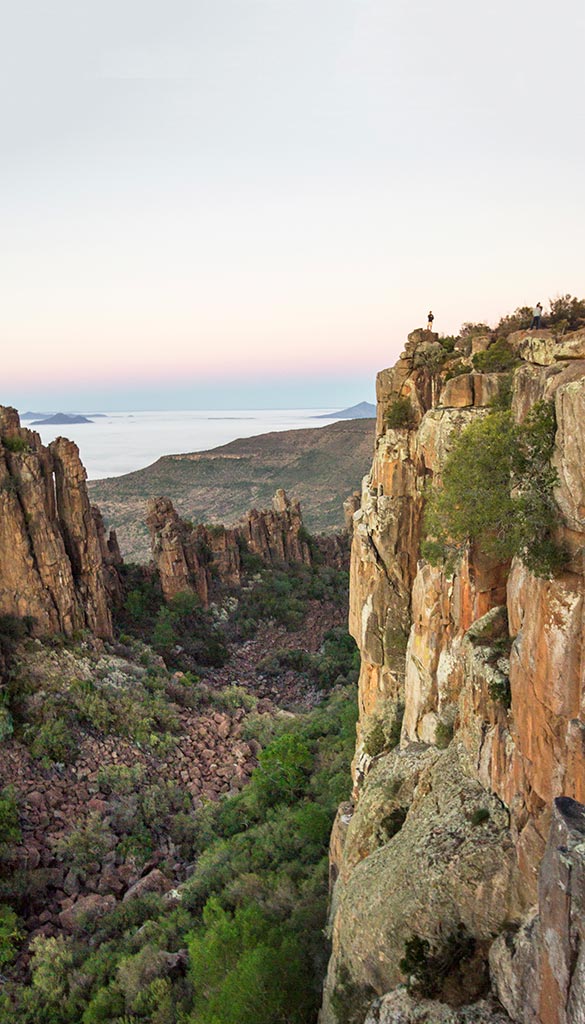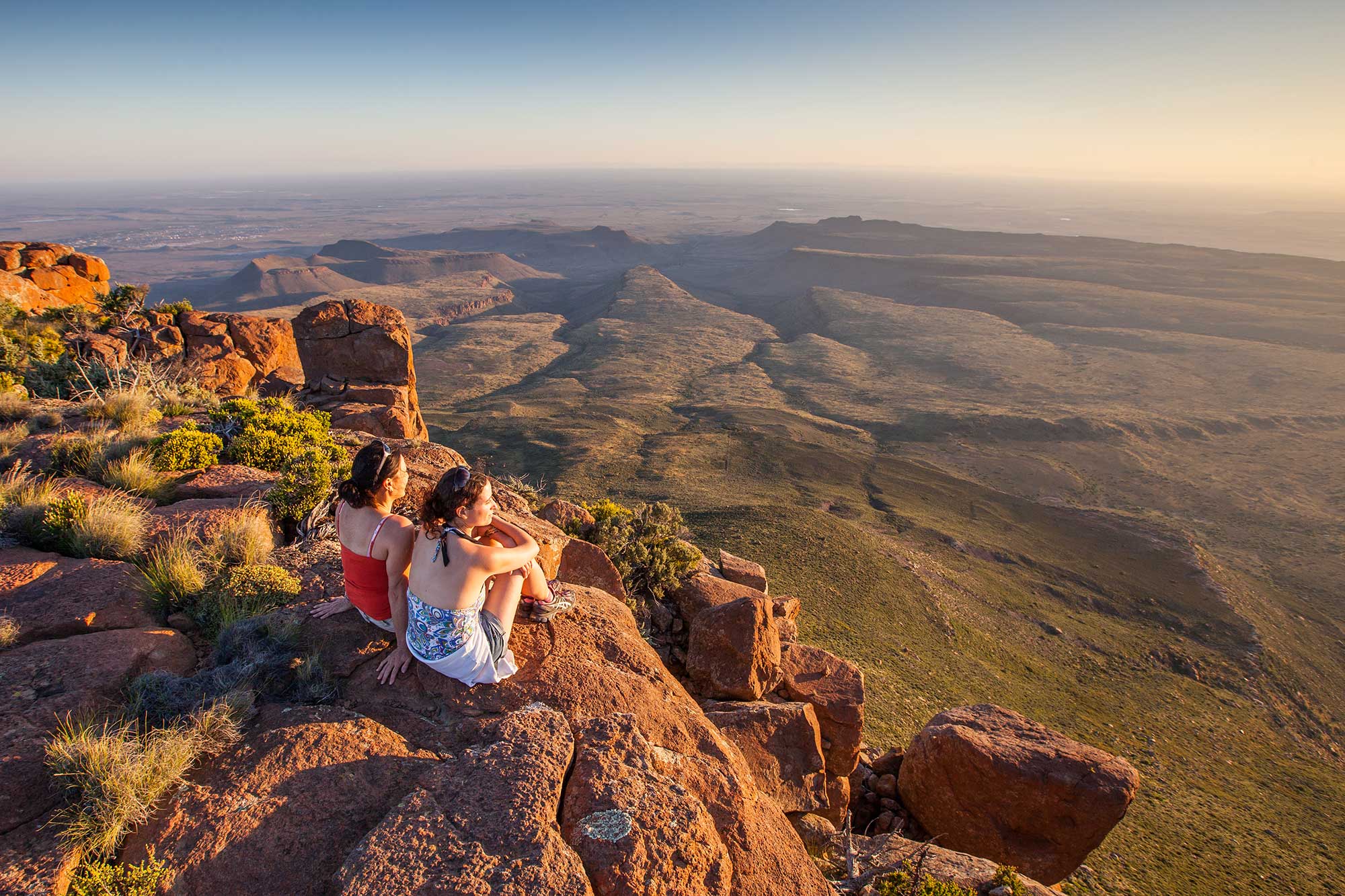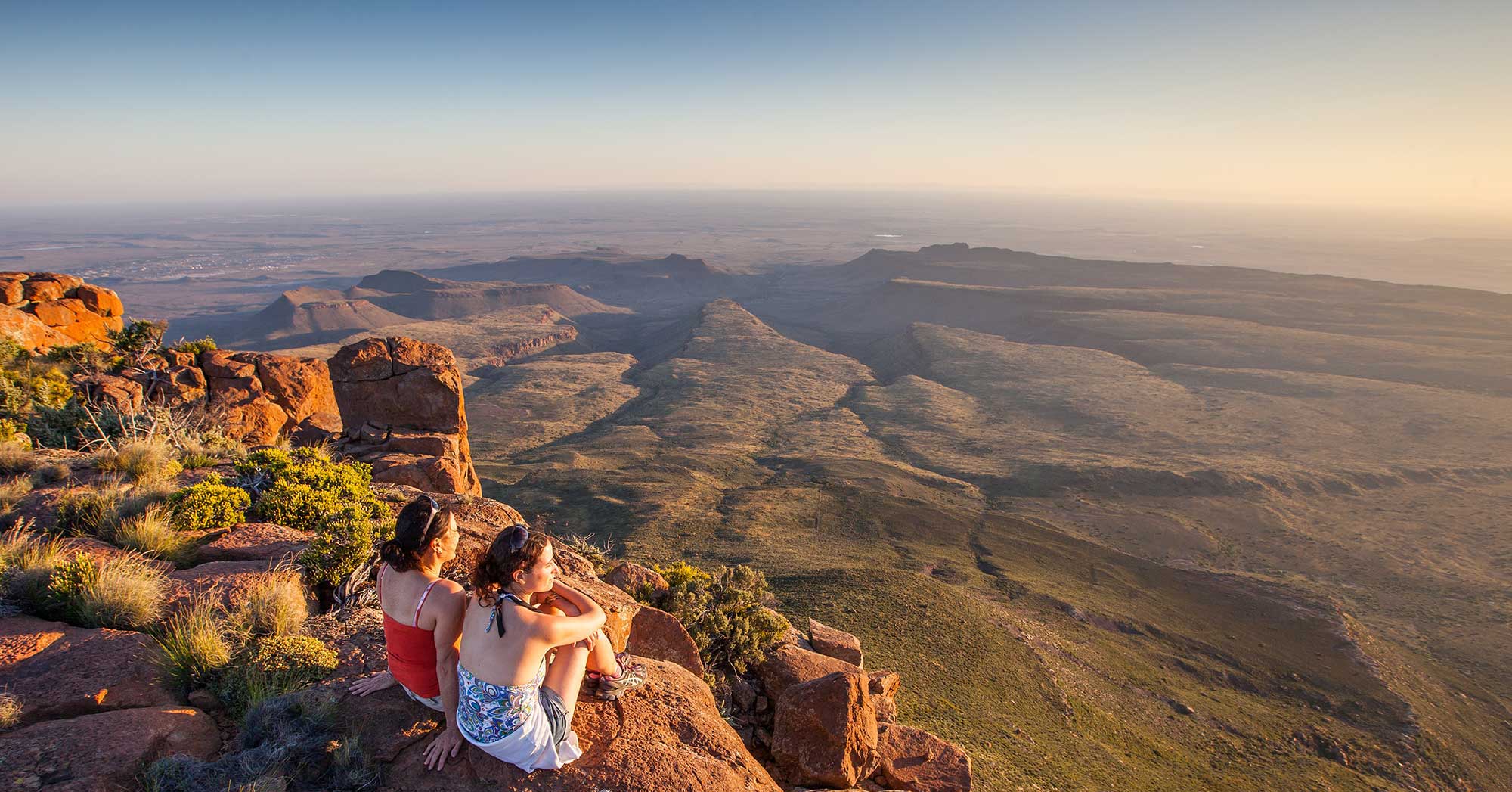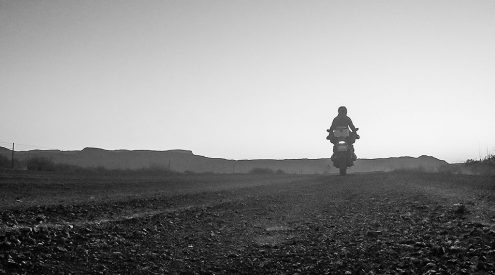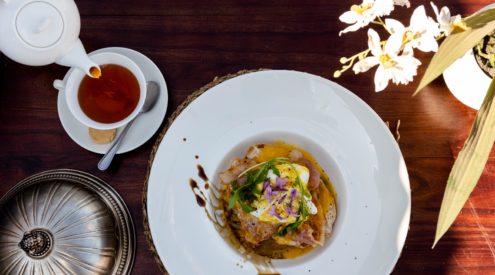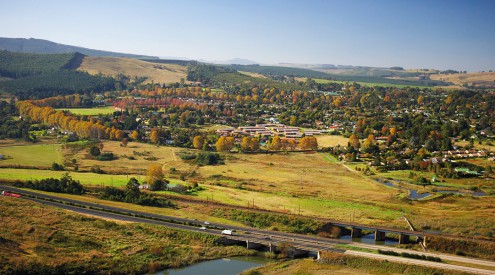For wildlife and open spaces, Chris Davies, Tyson Jopson and Scott Ramsay detour off the N2 to visit five SANParks that join Cape Town and PE the wild way.
On the outskirts of Port Elizabeth, SA’s subordinate artery bends like a hot pipe around the city’s automotive industria. It’s fitting then that here, on the crook of an asphalt dual carriageway, a decision about directions must be made. Head west, along the coast and through the Garden Route? Or go inland and lace five top national parks together on a week-long journey of wildlife viewing and unforgettable views? No points for guessing which way we’d go…
1. Addo Elephant Park
Interesting fact: In 1931, when Addo was proclaimed a national park, Cape elephants were on the brink of extinction with no more than 11 remaining in the area.
Also read: The best elephant-spotting route in Addo.
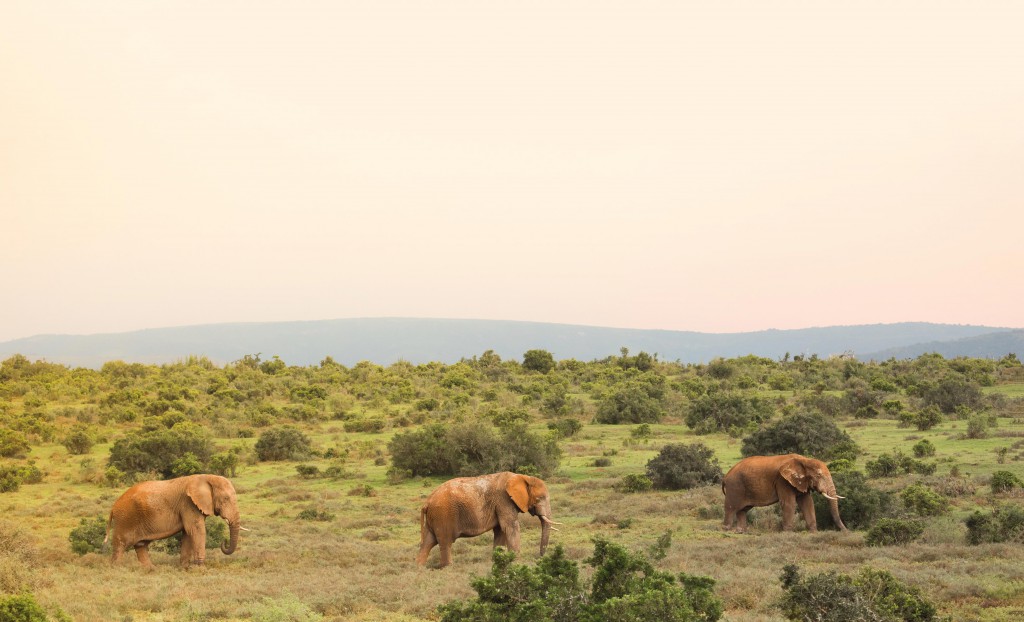
Addo’s ellies can eat upwards of 250 kilograms of spekboom each a day. Photo by Chris Davies.
Just 30 kilometres outside of PE, in the backwaters of Colchester, is Addo’s Matyholweni Gate, which splits the park into two. The recent addition of The Woody Cape Sections, from the mouth of the Sundays River to Kenton-on-Sea, makes it the only park in the world ‘home’ to the Big 7 (great white sharks and southern right whales have now been added to its complement of wildlife on show – although your chances of spotting a great white are probably just fractionally higher than being eaten by one).
Driving into Addo’s main park is driving into a labyrinth of green swollen spekboom that, incidentally, grows to about the same height as an elephant and can render game imperceptible from as close as 10 metres. It’s nature’s invisibility cloak and for over 600 elephant that roam the park it’s also an equally magical food – it grows the more it’s eaten (a stem left on the ground can sprout an entirely new tree).
Despite the density, this doesn’t diminish the chance of seeing big game. Addo is ellie central and you’re more than likely to spot more than one distinct dust-bedaubed hide ambling down the road. Head to the Mbotyi and Vukani loops where there is a good chance of spotting lion. There’s a natural flow to Addo and driving its loops in search of rhino, hyena and Cape buffalo while making sure you don’t drive over one of its equally important poo rollers the flightless dung beetle will almost always ensure you pop out a little further than where you started, and a little closer to the next destination.
Where to stay in Addo Elephant Park
SANParks has two rest camps in Addo. The Addo Main Rest Camp comprises everything from campsites and tented camps to forest cabins, chalets, rondavels and a guest house. Matyholweni Camp is quieter and has 15 self-catering chalets. Camping in the main camp costs from R280 for two people (maximum four) while other accommodation starts from R670 for two people.
Contact: Tel 0422338600, [email protected], www.sanparks.co.za/parks/addo
2. Mountain Zebra National Park
Interesting fact: At 284 square kilometres, it’s the second smallest SANPark with lions (the first is Mapungubwe) and the chance of spotting them in the short Karoo grassland is good.
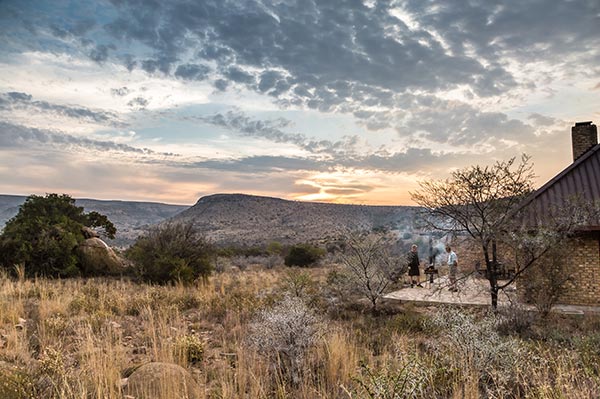
Each of the 19 family chalets at Mountain Zebra National Park has a wide stoep, braai place and great views. Photo by Chris Davies.
The road north from Addo breaks through the coastal hills at Olifantskop Pass and in a blink you’re in the Karoo. Tufts of sunbaked grass stretch to the horizon as the N10 snakes towards Cookhouse, where the waters of the Great Fish River feed swathes of green lucerne under scrub-covered ridgelines.
It’s over a three-hour drive from Addo and it’s best to take your time – Mountain Zebra National Park is a place to arrive at late afternoon. Cradock’s True Living restaurant, Lani’s Farm Kitchen, is a great spot to take a break. There’s good coffee, homemade deli food, even Wi-Fi if you want it. Just be sure you arrive at the park gates for that golden afternoon light. The grasses glow. And the otherwise dun-coloured hills turn a luminous bronze as they stretch away to the West.
Look out for lions (introduced to the park in April 2013). They’re ideally camouflaged in the Karoo grassland, but because the park is compact there is still every chance of seeing them on one of the three short loops from the single rest camp. Indeed, its small size is what makes Mountain Zebra National Park so attractive. You won’t find long queues of traffic here.
There’s also cheetah. They were first released into this Park ten years ago and the park is the only one which offers a cheetah tracking activity. Over the years, the Park has also played an integral role in contributing to the cheetah metapopulation of South Africa.
It’s a place to relax and if you are staying overnight it’s hard to imagine that you’re just 10km from Cradock, standing around a braai, when a lion roars somewhere off in the night.
Where to stay in Mountain Zebra National Park
There is one campsite which has 20 powered stands that operate on a first-come first-serve basis. There are 19 family cottages, a restored Victorian farmhouse (check if open), and two cottages tucked away from the main camp and only accessible by 4X4. The latest addition is eight beautiful, new Rock Chalets, which sleep up to four people for R3170. Camping costs from R295 for two people (maximum six) and cottages from R1150 for two people.
Contact: Tel 0488812427 / 0488813434, [email protected], www.sanparks.co.za/parks/mountain_zebra
3. Camdeboo National Park
Interesting fact: A plan is underway to grow a 66-hectare field of indigenous desert plants, succulents and cacti in the colours of SA’s national flag in the Valley of Desolation. It will be visible from space.
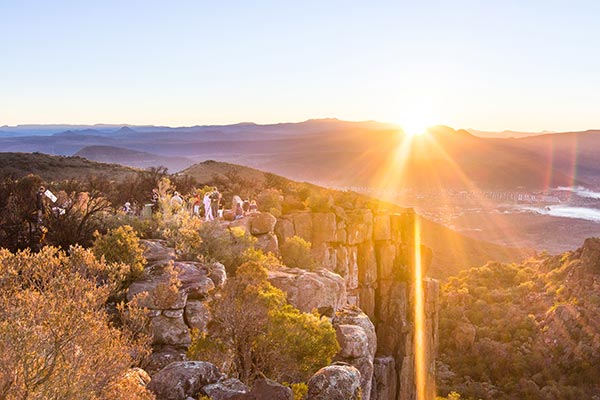
In Camdeboo, a short, 1,5-kilometre hiking trail joins the best viewpoints over the Valley of Desolation. Photo by Tyson Jopson.
If the flat-earth society ever felt the need to seek exoneration, they might find it heading west out of Mountain Zebra National Park. Arrow-straight roads charge towards pancake horizons which break only on occasion for solitary butter-block mountains. It’s a three-hour drive to Camdeboo, a park that is more about the panoramas than it is about wildlife. Here, dawn crests with purpose and dusk dwindles like it has nowhere better to go. Big skies silhouette game on the plains such as Cape mountain zebra, hartebeest, springbok and kudu between towering koppies and slender valleys.
You could easily be in and out of the 195 square kilometre park in half a day, but if you hold one thing sacrosanct, make it watching the sun go down over the Valley of Desolation (while certainly a striking name, it is a bit of a misnomer – more than 300 plant species inhabit the valley). The park is open past sunset on weekends for this express purpose and watching the pastel pink light fade as Graaff-Reinet flickers to life in the valley below is enough to rouse an existential stirring no credit card can quell.
Where to stay in Camdeboo National Park
Lakeview Tented Camp has four furnished tents that sleep two people each. There is also the Nqweba Campsite which has 15 sites, each with braai facilities and power outlets. Camping is from R240 for two people (maximum six) and tented camps are from R695 for two people.
Contact: Tel 0498923453, [email protected], www.sanparks.co.za/parks/camdeboo
4. Karoo National Park
Interesting fact: More than 250 million years ago (predating dinosaurs) the Karoo was home to what may have been the Earth’s first true mammals, now fossilised in the hard dirt.
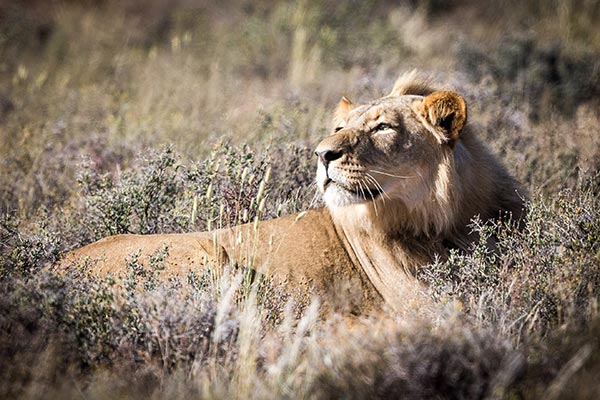
One of the Kgalagadi lions that were reintroduced into Karoo National Park, the first to roam the region in almost 200 years. Photo by Scott Ramsay.
From Camdeboo National Park, it’s a long pull west through the Karoo, South Africa’s defining biome, to its eponymous national park.
This seemingly barren and empty expanse is like a long, complicated novel that takes several chapters to get into. But a little perseverance, and the story hooks you till the very end. The national park, which starts just outside Beaufort West, contains the best Karoo scenery of all, dominated by basalt cliffs of the Nuweveld escarpment where Verreaux’s eagles soar. Drive the scenic Klipspringer Pass and the 46-kilometre Nuweveld 4×4 loop which accesses the very heart of the park.
The Karoo’s semi-arid climate supports far less wildlife than, say, Kruger, but because of open terrain and short scrubland (with a surprising 860 plant species), there’s a good chance of seeing springbok, gemsbok, red hartebeest, black wildebeest, eland and the largest population of Cape mountain zebra in the country – about 500. Since the re-introduction of lion in 2010 (the first since 1830), visitors are restricted to their vehicles and may not walk without a guide.
The rare black rhino and the even rarer riverine rabbit (one of South Africa’s most endangered species) are unlikely to be seen, but are integral to this park’s importance. There is a palpable sense of timelessness in the Karoo. Perhaps it is the billions of fossils from some 255 million years ago that lie entombed in the sedimentary rocks, or perhaps it’s the gigantic Karoo night sky and the way it pulls your gaze back billions of years into the known universe.
Where to stay in the Karoo National Park
The main rest camp has 38 cottages and the campsite has 30 stands with communal ablutions. The isolated Embizweni Cottage is situated on the Nuweveld 4×4 loop. Camping is from R295 for two people (maximum six) and cottages from R1250 for two people.
Contact: Tel 0234152828, [email protected], www.sanparks.co.za/parks/karoo
5. Bontebok National Park
Interesting fact: With about 200 bird species, Bontebok’s varied landscape is an excellent place to spot the rare quail finch and Stanley’s bustard.

Fishing at Bontebok requires a fishing permit. It costs R45 and can be bought from Cape Nature offices or at the park reception. Photo by Chris Davies.
At just 28 square kilometres, Bontebok is the smallest of all the SANParks – a dainty postage stamp of lethargic Breede River, framed by aloes and the ever-changing hues of the Langeberg mountains. The drive from the north cuts through a succession of passes: first the Meiringspoort Pass to De Rust and from there along the R62 to Barrydale, the Tradouw Pass and Swellendam.
Each passing kilometre brings greener scenery and on reaching Bontebok the contrast is complete. The barren Karoo is a distant memory, and the wide cool waters of the Breede River are perfect for swimming, canoeing and fishing. It’s a great spot to tick off some of the rarer Cape bird species and the best way to end a wild road trip before tackling the short drive to Cape Town the next day.
Where to stay Bontebok National Park
There’s just one rest camp, with 10 one-room chalets (a sleeper couch allows up to four people), and four family bungalows which sleep up to six. There are 41 campsites, some with power. The one-room chalets are from R1135 per night for two people, and the family bungalows are from R1885 per night for four. Camping costs from R225 for two people (maximum six).
Contact: Tel 0285142735, [email protected], www.sanparks.co.za/parks/bontebok
This article first appeared in the March 2015 issue of Getaway magazine.
Please note that all prices were correct at time of publication, but are subject to change at each establishment’s discretion. Please check with them before travelling.
